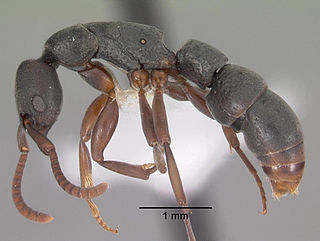
Hymenoptera is a large order of insects, comprising the sawflies, wasps, bees, and ants. Over 150,000 living species of Hymenoptera have been described, in addition to over 2,000 extinct ones. Many of the species are parasitic. Females typically have a special ovipositor for inserting eggs into hosts or places that are otherwise inaccessible. This ovipositor is often modified into a stinger. The young develop through holometabolism —that is, they have a wormlike larval stage and an inactive pupal stage before they mature.

The Indian flapshell turtle is a freshwater species of turtle found in South Asia. The "flap-shelled" name stems from the presence of femoral flaps located on the plastron. These flaps of skin cover the limbs when they retract into the shell. It is unclear what protection the flaps offer against predators. Indian flapshell turtles are widespread and common in the South Asian provinces. It is morphologically an evolutionary link between the softshell and hardshell aquatic turtles. Exploitation for profit and habitat change are threats to their survival.
Myrmecina difficulta is a species of ant in the family Formicidae.
Myrmecina eruga is a species of ant in the family Formicidae.
Myrmecina inaequala is a species of ant in the family Formicidae.
Myrmecina pumila is a species of ant in the family Formicidae.
Myrmecina silvalaeva is a species of ant in the family Formicidae.
Myrmecina silvampla is a species of ant in the family Formicidae.
Myrmecina silvangula is a species of ant in the family Formicidae.
Myrmecina silvarugosa is a species of ant in the family Formicidae.

Platythyrea is a genus of predaceous ants in the subfamily Ponerinae and the sole member of the tribe Platythyreini.

Cyphomyrmex is a genus of fungus-growing ants found primarily in South and Central America. However, some species do come up to the southern portion of North America. They grow a variety of fungi in the tribe Leucocoprineae. Most fungal gardens are grown in small nodules, some species to cultivate entire mycelium, though. Colonies are monogynous and are relatively small with about 100 workers on average.

A gamergate is a mated worker ant that can reproduce sexually, i.e., lay fertilized eggs that will develop as females. In the vast majority of ant species, workers are sterile and gamergates are restricted to taxa where the workers have a functional sperm reservoir ('spermatheca'). In some species, gamergates reproduce in addition to winged queens, while in other species the queen caste has been completely replaced by gamergates. In gamergate species, all workers in a colony have similar reproductive potentials, but as a result of physical interactions, a dominance hierarchy is formed and only one or a few top-ranking workers can mate and produce eggs. Subsequently however, aggression is no longer needed as gamergates secrete chemical signals that inform the other workers of their reproductive status in the colony.

Worker policing is a behavior seen in colonies of social hymenopterans whereby worker females eat or remove eggs that have been laid by other workers rather than those laid by a queen. Worker policing ensures that the offspring of the queen will predominate in the group. In certain species of bees, ants and wasps, workers or the queen may also act aggressively towards fertile workers. Worker policing has been suggested as a form of coercion to promote the evolution of altruistic behavior in eusocial insect societies.

Platythyrea parallela, is a species of ant of the subfamily Ponerinae. It is a cosmopolitan species.
Platythyrea clypeata, is a species of ant of the subfamily Ponerinae. It is found in Sri Lanka, and China.

Tyrannomyrmex rex is a species of ant in the family Formicidae.
Caenis punctata is a species of small squaregilled mayfly in the family Caenidae. It is found in Central America and North America.
Lachesilla punctata is a species of fateful barklouse in the family Lachesillidae. It is found in Central America and North America.
Paurocoris is a genus of dirt-colored seed bugs in the family Rhyparochromidae. There are at least two described species in Paurocoris.








